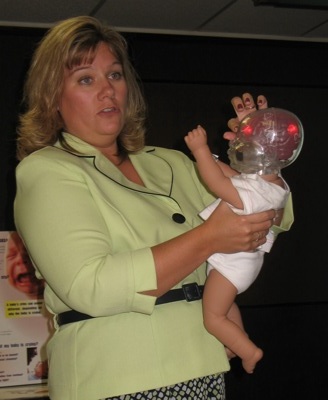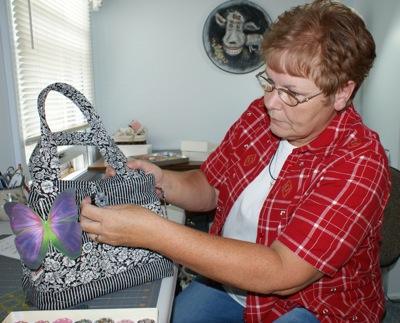Friday, September 18th, 2009
Never, ever shake a baby
Program teaches how to cope before child is hurt or worse
By Margie Wuebker

Photo by Margie Wuebker/The Daily Standard
Jennie L. Horner, coordinator of the Community Support Network in Lima, demonstrates the effect shaking can have on an infant. Red spots denote evidence of brain damage. Horner spoke about Shaken Baby Syndrome on Thursday during a Dine & Discover program at Mercer County Community Hospital in Coldwater.
COLDWATER - The baby wails continuously despite valiant efforts to comfort him. The parent, tired from a long day at work and frustrated by all the crying, picks up the baby intent on making one more attempt to stop the crying.
This is the time to place the baby in a safe place like a crib and walk away briefly to regain composure or to call someone for help, says Jennie Horner, coordinator of the Community Support Network for the Brain Injury Association of Ohio.
Unfortunately rattled parents don't always use this technique, she continues. Instead they shake the child inflicting brain injuries, coma and even death, Horner said.
Horner, guest speaker for Thursday night's Dine & Discover program at Mercer County Community Hospital in Coldwater, defined Shaken Baby Syndrome (SBS) as brain damage caused when an infant or preschool-age child is violently shaken or thrown. It is a serious form of child abuse from which no area is immune; even Mercer County recorded two likely cases during the past year.
With the use of a computerized doll, Horner demonstrated how even gentle shaking can cause injury. A red spot appeared at the back of the doll's brain encased in a plastic head as she shook the tiny body in what some might consider playful fashion.
"The motion caused the brain to slam against the back of the skull," she said pointing to the telltale spot in an area that controls eyesight. "And it has affected vision to some extent."
Horner added the smaller the child, the greater the likelihood of injury. This is due to many factors including the weight of the child's head which accounts for roughly 25 percent of body weight. Additionally, an infant's neck muscles are weak and unable to resist movement. There is space inside the cranium allowing the brain to grow; consequently any force causes greater movement of the delicate organ that controls vital body functions. Another factor is a network of delicate veins inside the head that tear and bleed easily.
Statistics indicate that one shaken baby in four dies while those who survive often have serious injuries. Estimates peg the number of victims between 1,200 and 1,600 in the country annually. Only one in five cases is diagnosed leading Horner to believe the numbers are much higher.
Victims range in age from several months to more than a year. Horner showed a video documenting the life and death of a 16-month-old Wisconsin boy named Elijah. His father shook, punched and threw him after becoming frustrated when nothing would stop the boy's crying.
Indications of likely SBS are the absence of response to stimulus, a lethargic state, convulsions, difficulty breathing and the inability to track movement with the eyes. Less severe symptoms include agitation, altered sleeping patterns, slurred speech/inability to make sounds and the inability to nurse or feed.
"People who shake babies are not monsters or ex-cons," Horner said. "They are simply people who lose their cool and don't know what to do."
Seventy percent of the perpetrators are male while 62 percent are family members. Other caretakers and babysitters have been known to snap with uncontrollable crying being the number one trigger.
"Parents and babysitters think they did something wrong when a child continues crying," Horner said. "It's ok to lay the baby down in a safe place and walk away to regain composure. Babies don't cry themselves to death."
The National Center on Shaken Baby Syndrome has put together an informative video called "Period of PURPLE Crying." Horner would like to see new parents leave the hospital with the $3.50 video.
The acronym PURPLE describes the behavioral characteristics that normal babies go through and that can be frustrating. The characteristics include:
• P - Peak of crying. This typically occurs during the second month and decreases after that point.
• U - Crying comes and goes unexpectedly for no apparent reason.
• R - Resists soothing despite consoling efforts.
• P - Pain-like face. Infants look like they are in pain even when they are not.
• L - Long lasting crying that can go on for 30-40 minutes or longer.
• E - Evening crying. Crying occurs more in the late afternoon and evening.
"Babies cry for many reasons and education is an important part of prevention," Horner says. "Crying is what babies naturally do and what comes natural should not cause them to be shaken.
Anyone needing additional information on coping with crying babies should contact the Brain Injury Association of Ohio at 1-866-644-6242 or Horner's Area 5 office at 1-419-999-0251. Additional information is also available from the Ohio Department of Health's Help Me Grow program at 1-800-755-GROW.



